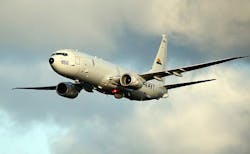Get out your crystal ball: Navy seeks to chart the future of ISR technologies for naval aviation
Officials of the Naval Air Warfare Center Aircraft Division in Lakehurst, N.J., issued a sources-sought notice (N6833518R0085) on Monday for ISR technologies that likely will come to bear on naval aviation over the next two decades.
Information gathered in this project will help position and inform the naval aviation community on resources that may be available in 5 to 20 years to contribute to ISR capabilities of the naval aviation community.
The idea is to support a quick and flexible outline of the warfighter's ISR capability relative adversaries' rapidly changing capabilities, Navy officials say. To do this the Navy is inviting the defense industry to brief their advanced research, planning, and strategic developments in ISR technologies that might be viable over the next 5 to 20 years.
Ultimately naval aviation experts would like to develop a recurring event with presentations of future ISR technology development, and invite representatives of Navy and other government research organizations to these briefings.
Navy experts are interested in hearing industry's views on where and how technology can and should be used in the ISR mission, with an understanding that the nature of warfare is changing at a rapid pace and in unpredictable directions.
Navy experts are asking for briefing from industry that touch on traditional ISR technologies, as well as on emerging technologies that use parts of the electromagnetic spectrum not traditionally used.
They want industry briefings on how all forms of intelligence like human intelligence (HUMINT), pattern of life, and open-source information can contribute to an informative picture of the battle space.
Related: L-3 to convert Cessna Caravan single-engine turboprop aircraft to surveillance platforms
Technologies and capabilities of highest interest are HUMINT; geospatial intelligence (GEOINT); measurement and signature intelligence (MASINT); open-source intelligence (OSINT); signals intelligence (SIGINT); technical intelligence (TECHINT); cyber intelligence and digital network intelligence (CYBINT/DNINT); and all subcategories of these disciplines.
Navy officials admit that it's difficult to predict the future of technology, but ask that companies respond with the breadth and depth of technical and operational coverage to lend merit to initial and future discussions.
Companies interested in participating should email 10-page responses to the Navy's John Toner no later than 21 Nov. at [email protected].
Email questions or concerns to the Navy's Paul Reimel at [email protected]. More information is online at https://www.fbo.gov/spg/DON/NAVAIR/N68335/N6833518R0085/listing.html.
Ready to make a purchase? Search the Military & Aerospace Electronics Buyer's Guide for companies, new products, press releases, and videos
